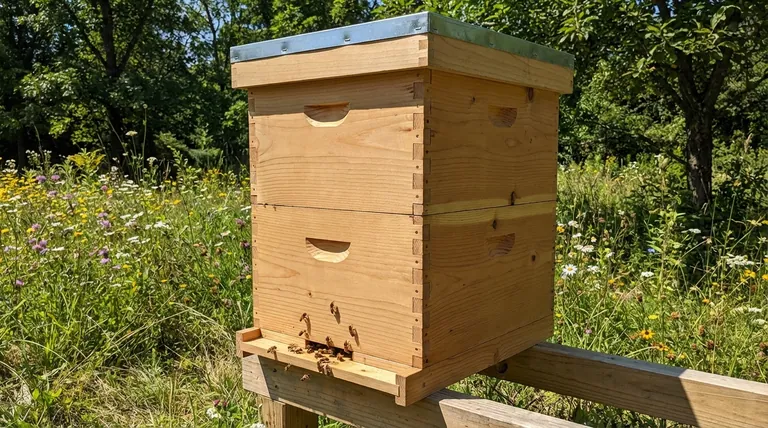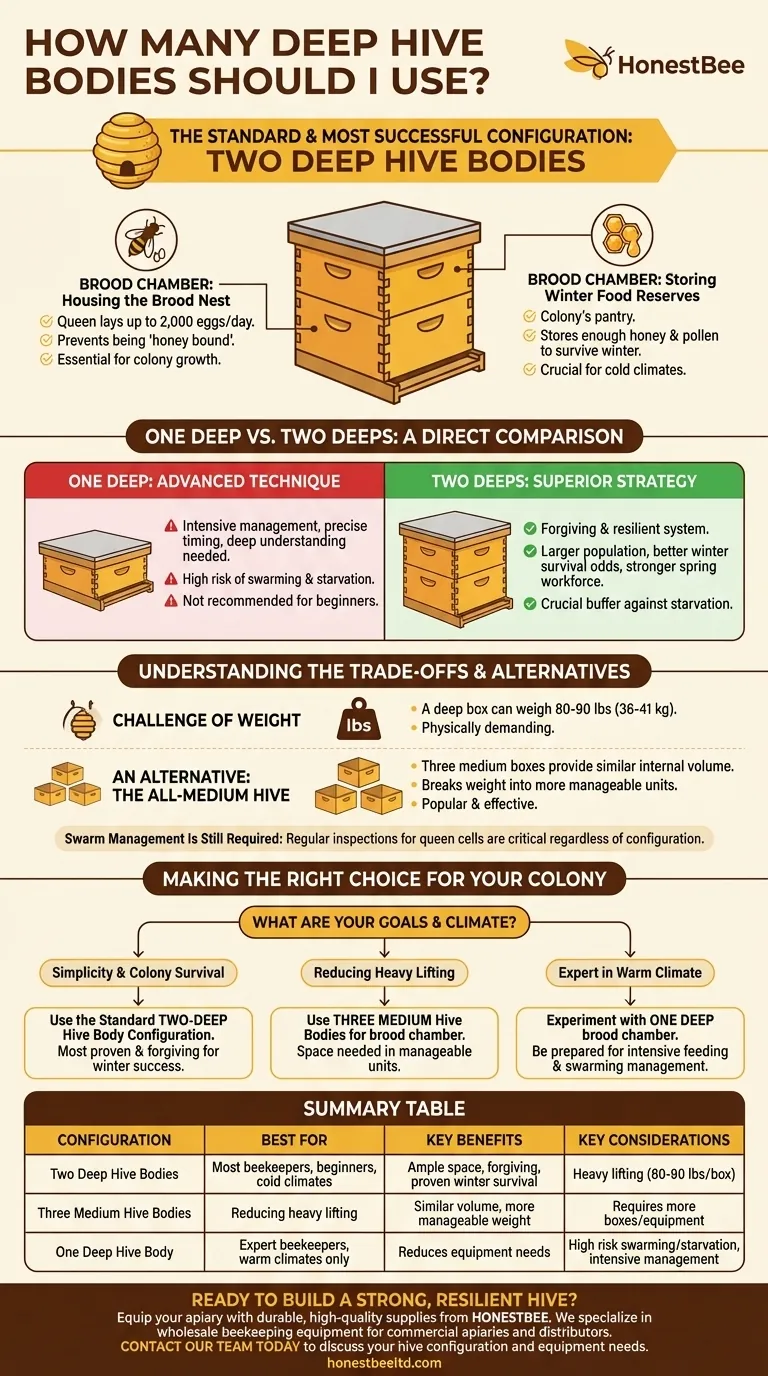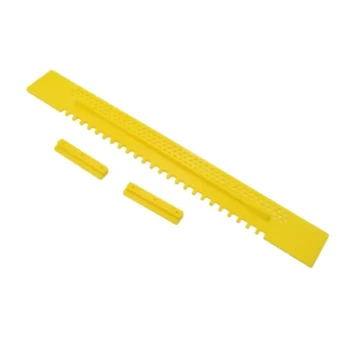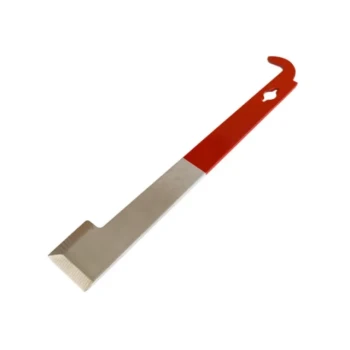For most beekeepers in most climates, the standard and most successful configuration is to use two deep hive bodies for the brood chamber. This setup provides the necessary space for the queen to lay eggs and for the colony to store enough food to survive the winter.
The question isn't just about the number of boxes, but about providing the right amount of space for two critical functions: raising brood and storing winter food. The two-deep hive configuration is the most reliable way to meet both of these needs.

The Purpose of the Brood Chamber
The deep hive bodies at the bottom of the hive are not for the honey you plan to harvest. This is the bees' living space, the engine room of the colony, known collectively as the brood chamber.
Housing the Brood Nest
The primary purpose of the brood chamber is to house the brood nest. This is where the queen lays her eggs—up to 2,000 per day—and where the nurse bees raise the next generation of workers.
A single deep box can quickly become too small for a prolific queen, a condition known as being "honey bound" or "pollen bound." This lack of space can restrict colony growth and is a primary trigger for swarming.
Storing Winter Food Reserves
The second deep box serves as the colony's pantry. Bees will fill this upper deep box with the honey and pollen they need to survive the winter.
A single deep box rarely provides enough storage space for a colony to overwinter, especially in climates with long, cold winters. Relying on one deep box puts the colony at high risk of starvation.
One Deep vs. Two Deeps: A Direct Comparison
While the two-deep setup is standard, some beekeepers advocate for a single-deep brood chamber. Understanding the reasoning behind each method is key.
The Argument for a Single Deep
Proponents of a single-deep system often do so to reduce the weight of hive components. They manage the limited space through intensive feeding and rigorous swarm prevention.
This is an advanced technique that requires precise timing and a deep understanding of bee biology. It is generally not recommended for beginners or for beekeepers in cold climates.
The Overwhelming Case for Two Deeps
For the vast majority of beekeepers, using two deeps is the superior strategy. It creates a much more forgiving and resilient system.
The benefits are clear: a larger, more robust population of bees, significantly better odds of winter survival, and a stronger workforce ready for the spring honey flow. The second deep acts as a crucial buffer against starvation.
Understanding the Trade-offs
Choosing a hive configuration involves balancing the needs of the bees with the practicalities of beekeeping.
The Challenge of Weight
The primary drawback of a two-deep system is weight. A deep box full of honey and brood can weigh 80-90 pounds (36-41 kg), making inspections physically demanding.
An Alternative: The All-Medium Hive
To solve the weight problem, many beekeepers use three medium-depth boxes for their brood chamber instead of two deeps.
This provides a similar internal volume for the brood nest and food stores but breaks the weight into more manageable units. This is an excellent and increasingly popular alternative that does not compromise colony health.
Swarm Management Is Still Required
While providing adequate space can help reduce a colony's impulse to swarm, it does not eliminate it. Regular inspections to check for queen cells and manage space are critical regardless of your hive configuration.
Making the Right Choice for Your Colony
Your decision should be based on your climate, your physical ability, and your beekeeping goals.
- If your primary focus is simplicity and colony survival: Use the standard two-deep hive body configuration. It is the most proven and forgiving method for ensuring colony health and winter success.
- If your primary focus is reducing heavy lifting: Use three medium hive bodies for your brood chamber. This gives the bees the space they need in units that are much easier to handle.
- If you are an expert in a warm climate: You might experiment with a single-deep brood chamber, but you must be prepared to manage feeding and swarming with constant diligence.
Ultimately, providing your colony with sufficient space for both brood and food is one of the most fundamental duties of the beekeeper.
Summary Table:
| Configuration | Best For | Key Benefits | Key Considerations |
|---|---|---|---|
| Two Deep Hive Bodies | Most beekeepers, especially beginners and those in cold climates. | - Ample space for brood and winter food. - Forgiving and resilient. - Proven success for winter survival. |
- Heavy lifting required (80-90 lbs per box). |
| Three Medium Hive Bodies | Beekeepers seeking to reduce heavy lifting. | - Similar internal volume to two deeps. - More manageable weight per box. |
- Requires more boxes and equipment. |
| One Deep Hive Body | Expert beekeepers in warm climates only. | - Reduces equipment needs. | - High risk of swarming and starvation. - Requires intensive, advanced management. |
Ready to build a strong, resilient hive?
Choosing the right hive bodies is just the first step. Equip your apiary with durable, high-quality supplies from HONESTBEE. We specialize in wholesale beekeeping equipment for commercial apiaries and distributors, helping you build a thriving operation.
Contact our team today to discuss your hive configuration and equipment needs. Let us help you ensure your colony's health and productivity.
Visual Guide

Related Products
- Australian Langstroth Beehive Boxes for Beekeeping Wholesales
- Langstroth Honey Bee Box Hive Boxes for Different Depths
- Langstroth Bee Hives Bee Keeping Box for Beginners Beekeeping
- Professional Insulated Plastic Bee Hives
- Professional Insulated Winter Hive Wrap for Beekeeping
People Also Ask
- Why might a beginner be advised to start with a Langstroth hive? Unlock a Supportive Beekeeping Ecosystem
- What are beehive boxes, and what are they used for? The Essential Guide to Hive Components
- What is the best hive for beginners? A Guide to Langstroth, Top Bar, and Flow Hives
- What is the purpose of reversing brood chambers in the spring? A Proactive Swarm Prevention Strategy
- What are the sizes of supers available in a standard hive? A Guide to Deep, Medium, and Shallow Boxes



















